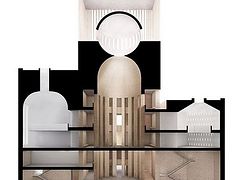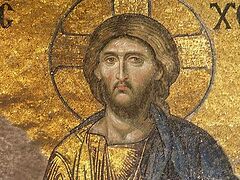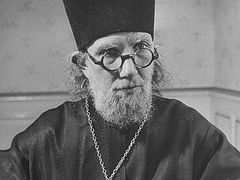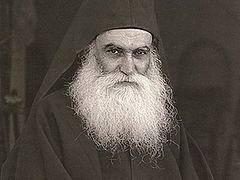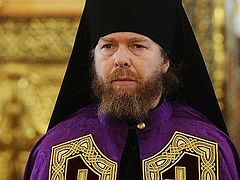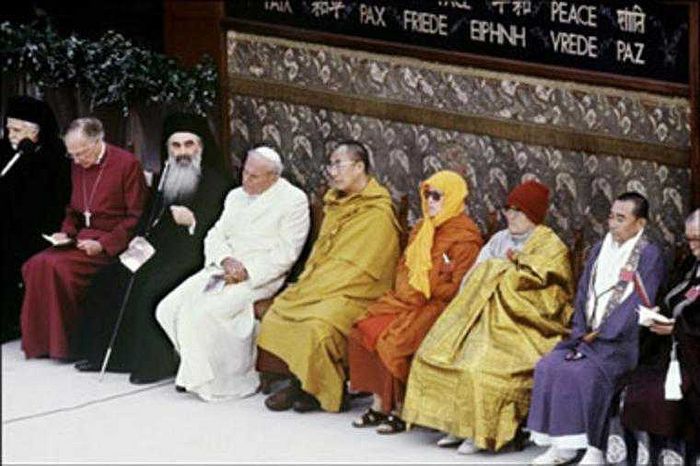 Interfaith Summit, Assisi. 1986.
Interfaith Summit, Assisi. 1986.
This subject has in recent years become a pressing matter in connection with a wide range of events taking place in today’s world. Special attention is paid to the eradication of boundaries between such notions as cultural and national characteristics, worldviews, religions, and, what is truly hard to believe, to the blurring of differences between genders (by word “pol,” I don’t mean the floors we walk on [this is a play on words—“pol” is the word for both “gender” and “flooring” in Russian.—Trans.), but masculine and feminine gender. It is like Chichykov, Gogol’s main character in his novel, Dead Souls, who went up to Plyushkin but couldn’t figure out his gender and kept wondering: “Maybe a guy, but it could be a gal.”)
Some terrible virus has stormed into the world and crippled it! It brings to mind the Biblical tree of knowledge of good and evil and its fruit, which God forbade the first humans to eat so that they wouldn’t die. Many commentators consider the idea of the tree as nothing other than the erosion in the mind of man of the distinction between good and evil, beauty and ugliness, truth and lies. In this confusion, these concepts are eliminated and become so indistinguishable to man that it almost seems as if neither good nor evil exists any longer. What then remains? Since there is no longer any goodness, evil is taking over.
Such is today’s tendency, which is gaining further control over the human mind because it is being promoted so aggressively. A whole range of factors acts as an indicator and a warning sign of sorts about things that are yet to come.
For example, back in 1986 in Assisi (Italy), the Pope of Rome John Paul II organized the World’s Interfaith Summit with the motto of, “Prayer for Peace.” Scores of representatives of different religions arrived there, including the Pope himself, the Patriarch of Constantinople, a Russian Metropolitan, the Archbishop of Canterbury, the Dalai Lama, and shamans—simply a modern day Noah’s Ark. They announce their prayers for peace (though it is hard to believe that they actually pray). Truth be told, they did pray separately, each one in the tradition of their own faith. Once during a visit abroad, I was shown an altar table in a Catholic church that the Buddhists asked to cover so that it would not interfere with their ritual as they placed with a statue of Buddha on top of the altar.
Beginning from 1986, these inter-faith gatherings to “pray for peace” have been held annually. Not only did they take place every year but they also brought about a gradual process of becoming further habituated with the convergence of worship rituals of different faiths, and increasing apathy regarding the canonical distinctions between them. In 2011, they invited atheists to this gathering—mind you, to a religious conference entitled, “Prayer for Peace”! I wonder what god did [the atheists] pray to for peace? Later on, they initiated a joint prayer including representatives of all faiths, in contrast to the former rule of everyone praying separately.
Here is another fascinating story. In 2014, an opening, or inauguration, of the “Temple of Solomon” took place in Sao-Paolo, Brazil. It is a gigantic temple, one of the largest in the world, built so that representatives of all religions could worship there. Frankly speaking, its opening ceremony was quite a sight as well: Can you guess what six men dressed in white garments ceremoniously carried out on a stretcher? You’ll guess it all wrong! In the “temple of all religions,” they carried “The Ark of the Covenant,” the symbol of the Jewish religion. How is it possible to combine the first commandment of the Mosaic Law, “I am the Lord your God”, with the possibility of worshipping other gods in this temple, when Judaism has always fought so jealously against them! It will remain a mystery for the unenlightened man. However, the fact is plain to see that all religions can merge here without any renunciation of their fundamental beliefs.
The temple during this “inauguration” was filled with the representatives of heaven knows how many religions, not to mention the presence of all major politicians from Brazil and other countries, leading business figures, and the cultural elite. Interestingly enough, the President of Brazil was present at the opening of this temple as well. The event took place in 2014.
Let’s look at the year 2015. Pope Francis published a book that holds a collection of about 300 questions. During, or in relation to, a book launch presentation, they offered an interesting promo video for viewing. Four men—a Christian, a Buddhist, a Muslim, and a Jew—are asked the question, “Who do you believe in?” “In Christ,” says the Christian, “In Yahweh,” says the Jew, “In Buddha,” says Buddhist, and “In Allah,” the Muslim answers. Everything is quite clear up to this point. Next, they answer another question: “Can the God you worship be called “love”?” Everyone answers: “Yes, of course!” The final clip shows all four of them locking hands together in pure harmony. It is amazing, isn’t it? It does look like we are nearing the end, because as it turns out, the representatives of all faiths profess the same thing: love. Could there possibly be anything loftier than that, and consequently can any religious dogma be an obstacle to the declaration that all faiths are one in substance, that they worship one God, even if they believe differently in Him?
This video is quite symptomatic and speaks volumes about the process that Hieromonk Seraphim (Rose), an American Orthodox Christian ascetic, had prophesied about in his book, “Orthodoxy and the Religion of the Future.” It discusses the integration of different faiths into a single doctrinally amorphous phenomenon.
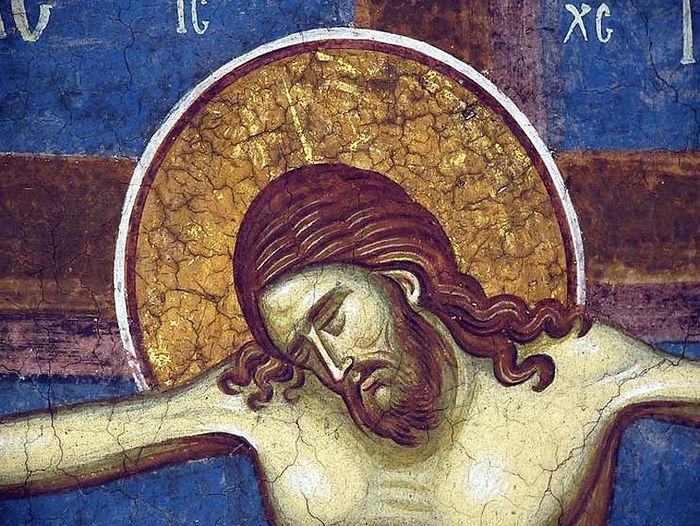 Holy and Great Friday. The death of Christ. Fresco at the monastery of Vysoki Decani, Serbia. 14th c.
Holy and Great Friday. The death of Christ. Fresco at the monastery of Vysoki Decani, Serbia. 14th c.
What will this integration bring to Christianity? Christianity declares truths that are absolutely incompatible with other faiths. Where else would one find the teaching about the consubstantial and undivided God as the Trinity of the Father, Son, and the Holy Spirit? Or, how about the Incarnation of God the Logos, the Second Person of the Holy Trinity? Or the Savior Who voluntarily accepted death on the cross for the salvation of mankind? Or the teaching of salvation as the acquisition of holiness instead of the deliverance from all earthly cares, etc? This artificially fabricated universal faith has no room for what is essential in Christianity! Apostle Paul has eloquently spoken about it: But we preach Christ crucified, unto the Jews a stumbling block, and unto the Greeks foolishness (1 Corinthians 1:23). Christianity is entirely excluded from this universal religion that is currently undergoing its formative stage of development through the efforts of powerful world players, one of them being the Vatican.
The concept of creating a universal religion based on faith in one God eliminates Christianity, since its existence is impossible without the confession of Christ as true God and ultimate Savior. This is so because the universal religion of the future essentially denounces the significance of absolute truths about faith and life as formative concepts, except for the most common ones that can stand for any random beliefs, including mutually exclusive ones. A prophet from the book of Deuteronomy in the Bible condemns the Jews: “You worshipped demons, not God.” Apostle Paul says: “I do not want you to worship demons.” It turns out the idea of God can be degraded so low that it becomes devil worship instead. Compare Christ and some multi-armed goddess Kali, the goddess of world destruction bedecked with human skulls…
The idea of one God in all religions is just an empty abstraction. This is so, because in every religion, God is not God Himself, Who is ineffable Spirit, but the image of Him present in that particular religion. Thus, even Christianity names Jesus Christ, the Son of God, the image of the invisible God (2 Corinthians 4:4; Colossians 1:15), the form of God (Philippians 2:6), the brightness of His glory and the express image of His person (Hebrews 1:3).
Believers are also guided by the image of their God. Whatever nature God possesses is what man is also expected to have. A special mindset, a unique spiritual order, and a specific character of the spiritual and moral life of a believer are formed in every religion. That is why the Apostle Paul exclaimed, And what communion hath light with darkness? And what concord hath Christ with Belial? (2 Corinthians 6:14,15).

